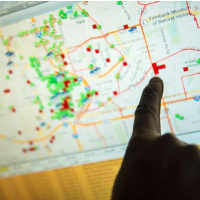Chicago Police Use of Computer-Predictions of Shooters and Victims Prompts Civil Liberties Concerns
 Predictive policing map (photo: Ann Hermes, Christian Science Monitor via Getty Images)
Predictive policing map (photo: Ann Hermes, Christian Science Monitor via Getty Images)
By Monica Davey, New York Times
CHICAGO — In this city’s urgent push to rein in gun and gang violence, the Chicago Police Department is keeping a list derived from a computer algorithm that assigns scores based on arrests, shootings, affiliations with gang members and other variables.
The authorities hope that knowing who is most likely to be involved in violence can bring them a step closer to curtailing it. They are warning those highest on the list that they are under intense scrutiny, while offering social services to those who want a path away from the bloodshed.
About three years into the program and on a fourth revision of the computer algorithm that generates the list, critics are raising pointed questions about potential breaches to civil liberties, and the list’s efficacy remains in doubt as killings and shootings have continued to rise this year.
So far this year, more than 70 percent of the people who have been shot in Chicago were on the list, according to police, as were more than 80 percent of those arrested for shootings.
Supporters of Chicago’s list say it allows police to focus on a small fraction of people creating chaos in the city rather than unfairly and ineffectively blanketing whole neighborhoods. But critics wonder whether there is value in predicting who is likely to shoot or be shot with seemingly little ability to prevent it, and they question the fairness and legality of creating a list of people deemed likely to commit crimes in some future time.
Uncertain, for now, is the effectiveness. The RAND Corp. is evaluating the city’s list, but results are yet to be published. Christopher Mallette, the executive director of the Chicago Violence Reduction Strategy, said that 21 percent of the individuals they have succeeded in talking to have sought assistance, and that fewer than 9 percent of the people they talked to have been shot since a home visit. A juvenile who has a high score on the list and who was visited last week was shot in the leg and injured Sunday, police said. They said he did not answer the door last week when the group went to his home.
To Learn More:
7,000 People Covertly Swept Up Into Secret Chicago Police Interrogation Center (by Noel Brinkerhoff and Steve Straehley, AllGov)
Chicago Fugitive Unit Zeroes in on “Hot People” (by Noel Brinkerhoff, AllGov)
- Top Stories
- Unusual News
- Where is the Money Going?
- Controversies
- U.S. and the World
- Appointments and Resignations
- Latest News
- Trump to Stop Deportations If…
- Trump Denounces World Series
- What If China Invaded the United States?
- Donald Trump Has a Mental Health Problem and It Has a Name
- Trump Goes on Renaming Frenzy






Comments